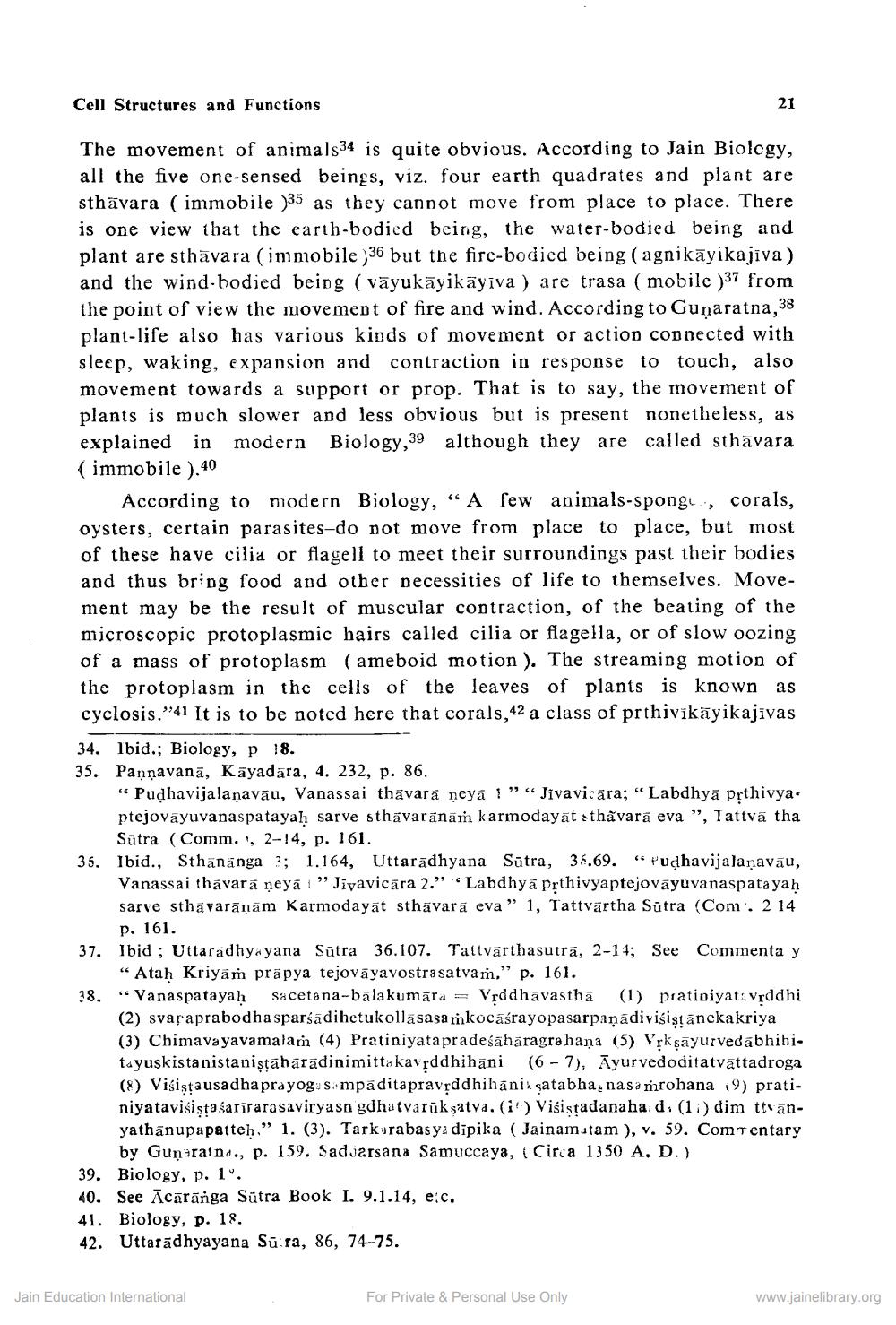________________
Cell Structures and Functions
21
The movement of animals34 is quite obvious. According to Jain Biology, all the five one-sensed beings, viz. four earth quadrates and plant are sthāvara ( immobile )35 as they cannot move from place to place. There is one view that the earth-bodied being, the water-bodied being and plant are sthāvara (immobile )36 but the fire-bodied being (agnikāyikajiva) and the wind-bodied being (vāyukāyikāyīva ) are trasa ( mobile )37 from the point of view the movement of fire and wind. According to Gunaratna, 38 plant-life also has various kinds of movement or action connected with sleep, waking, expansion and contraction in response to touch, also movement towards a support or prop. That is to say, the movement of plants is much slower and less obvious but is present nonetheless, as explained in modern Biology, 39 although they are called sthāvara (immobile ).40
According to modern Biology, “A few animals-spong, corals, oysters, certain parasites-do not move from place to place, but most of these have cilia or flagell to meet their surroundings past their bodies and thus bring food and other necessities of life to themselves. Movement may be the result of muscular contraction, of the beating of the microscopic protoplasmic hairs called cilia or flagella, or of slow oozing of a mass of protoplasm (ameboid motion ). The streaming motion of the protoplasm in the cells of the leaves of plants is known as cyclosis."41 It is to be noted here that corals,42 a class of prthivīkāyikajīvas 34. lbid.; Biology, p 18. 35. Pannavanā, Kāyadara, 4. 232, p. 86.
“ Pudhavijalanavāu, Vanassai thāvarā ņeya 1" “Jivavicāra; “Labdhyā prthivya. ptejovayuvanaspatayah sarve sthavaranam karmodayat athāvarā eva", Tattva tha
Sūtra (Comm., 2-14, p. 161. 35. Ibid., Sthānanga ?; 1.164, Uttaradhyana Sūtra, 39.69. "Pudhavijalanavāu,
Vanassai thávarā ņeya i "Jiyavicāra 2." Labdhya Prthivyaptejovāyuvanaspatayah sarve sthāvarāņām Karmodayāt sthāvarā eva" 1, Tattvārtha Sūtra (Com. 2 14 p. 161. Ibid ; Uttaradhyayana Sūtra 36.107. Tattvärthasutra, 2-14; See Commenta y
“Atah Kriyām prāpya tejovāyavostra satvam." p. 161. 38. “Vanaspatayah Sacetana-balakumāra = Vrddhāvasthā (1) pratiniyat: Vrddhi
(2) svaraprabodha sparśādihetukollasasa mkocaśrayopasarpaņādivisistānekakriya (3) Chimavayavamalam (4) Pratiniyatapradeśāhāragra hana (5) Vrksāyurvedābhibi. tayuskistanistanistāhārādinimitta kavrddhihāni (6-7), Ayurvedoditatvättadroga (8) Visiştausadha prayog sampaditapravặddhihāniäşatabha, nasa mrohana 19) pratiniyatavi istasafīrarasaviryasn gdhatvarūk satva.(1) Višistadana ha d. (1) dim ttvanyathānupapatteh." 1. (3). Tark rabasya dipika (Jainamatam ), v. 59. Commentary by Gunararni., p. 159. Sadjarsana Samuccaya, (Circa 1350 A, D.)
Biology, p. 1'. 40. See Ācārānga Sūtra Book I. 9.1.14, e c. 41. Biology, p. 18. 42. Uttaradhyayana Sū ra, 86, 74-75.
39. Biol08.
Jain Education International
For Private & Personal Use Only
www.jainelibrary.org




